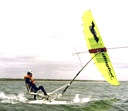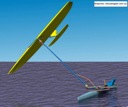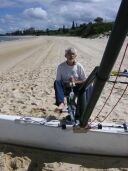

Trial 4 2005 Sydney Harbour
Learning to master the unique controls is proving a challenge. The stability of the craft in light breezes needs improvement. It capsizes too easily.
Learning to master the unique controls is proving a challenge. The stability of the craft in light breezes needs improvement. It capsizes too easily.
Back to the drawing board
Trial 3
Perfect day 15 knot breeze. Spent time tuning the pivot point of the wing to achieve the right balance between responsiveness and stability. Not perfect but we are eager to develop more Dingbat skills on the water.
Perfect day 15 knot breeze. Spent time tuning the pivot point of the wing to achieve the right balance between responsiveness and stability. Not perfect but we are eager to develop more Dingbat skills on the water.
Trial 2
Wing roll/wind shear mechanism is working well. But not much speed. Wing is not generating enough thrust.
We discover a new way to capsize.
Wing makes a wonderful sea anchor.
Bruised but nothing broken.
Wing roll/wind shear mechanism is working well. But not much speed. Wing is not generating enough thrust.
We discover a new way to capsize.
Wing makes a wonderful sea anchor.
Bruised but nothing broken.
It is gratifying that the design has accommodated the adjustments we have made and that no insurmountable obstacles have appeared. Nor have we broken anything. Biggest challenge is proving to be converting from theory to practice the sailing skills demanded by our unique craft.
Trial 1 of Dingbat 2 2004 Botany Bay
Everything slotted together and looking great - seriously radical. Wing is controllable and flies beautifully - almost.
Wing roll. When the Pilot wants Dingbat to be stationary, he rolls the wing to horizontal and sets it to fly 'hands off'. When he wants Dingbat to proceed he causes the wing to provide horizontal thrust by rolling it to one side and increasing its angle of attack. The roll angle is controlled by the joy stick. This system works! A win.
Wind shear. Another challenge is to deal with the effect of wind shear which attempts to drive the wing tip nearest the water further downwards. The servo mechanism that automatically counters this effect was trying to work but needed tuning.
(We note that designers of other 'winged craft' deal with wind shear and the weight of the wing by supporting it on a float - which creates its own problems.)
Our first capsize. Nothing broken.
2003
Bill Rayner breaks neck in surfing accident. (one of the hazards of living in Sydney). Development slowed but enthusiasm maintained
Bill Rayner breaks neck in surfing accident. (one of the hazards of living in Sydney). Development slowed but enthusiasm maintained
Launch of Dingbat 2 now December - January
2002
Clean-sheet design of Dingbat 2 with more directional stability, less drag, greater wing force, refined controls, simplified capsize recovery.
Clean-sheet design of Dingbat 2 with more directional stability, less drag, greater wing force, refined controls, simplified capsize recovery.
2000
Patent applications for principal design elements.
Patent applications for principal design elements.
Construction of Dingbat 1 using sail boards to provide flotation.
Wet trials on Botany Bay demonstrated the validity of the technology and identified areas for further development.
Techniques for simplifying assembly, launching and dealing with capsizes addressed.
1999
Towing trials on a full-size wing showed it to be stable and controllable.
Towing trials on a full-size wing showed it to be stable and controllable.
Technique for dealing with the destabilising effects of wind shear proved OK.




Dingbat 1
Dingbat 2




Dingbat 1 and Dingbat 2